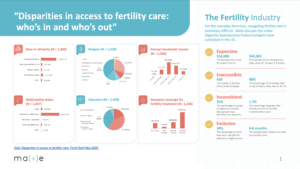While most people have easy access to reliable reproductive health care, this is not true for all individuals across the country or within individual states, nor has it always been the case. In fact, a growing body of research shows that even if you are healthy and do not suffer from any medical conditions related to having children, your ability to conceive can be hindered by where you live and what services you have available to you.
This article will talk about some of the disparities in access to fertility care that exist among wealthy, middle-class, and low income communities, as well as within individual state healthcare systems. It will also discuss why these differences occur and how they may negatively affect someone’s chance at conception or treatment of an existing condition.
I hope you will take something away from reading this article, whether it is information about a new disease or condition, or just an understanding of our current system. We should all be aware of the unequal distribution of quality, accessible health care in this country, and if you find yourself needing such services, know that there are resources available to help you.
General ills of our current healthcare system
We already discussed in length in past articles about the general issues with our current healthcare system, so we will skip over those here.
Instead, we will focus more specifically on issues surrounding infertility, pregnancy loss, and other birth control methods.
Who is at risk for disparities in access to fertility care?

While there are many factors that can contribute to someone’s ability to conceive, one of the major causes of infertility is a lack of access to quality health care. In fact, nearly half of all people who struggle with infertility cite cost as the main reason they stopped looking into treatments or procedures.
Infertile individuals may be denied needed care due to their insurance coverage or because they don’t feel their doctor/surgeon is “experts” in certain treatments like IVF. They might also face financial barriers when seeking out outside help since most medical professionals accept insurance.
There are several groups within our society that are more likely than others to experience significant disparities in access to high-quality healthcare including women, minorities, low income families, young adults, and seniors. People in these categories are disproportionately impacted by challenges accessing good quality reproductive health services.
According to an article published this past May by The Huffington Post, wealthy men are twice as likely to have a vasectomy as poor men. This is because MVA (medical voluntary sterilization) requires two things: a physician and surgery, which often comes with expensive fees. Therefore, if you make enough money to afford both of those, your options increase. If you’re not rich though, it can be difficult to find a provider who will perform the procedure for you and even harder to pay for it yourself.
Sources: https://www.healthline.
Factors that affect access to fertility care

There are several factors that can play a role in whether or not you have easy access to quality reproductive health services.
Some of these include where you live, your income level, if you have medical insurance, and whether there is a nearby provider who offers the same services as more expensive options.
It’s important to remember that even though some people may have easier access to certain procedures than others, this doesn’t mean it’s possible for everyone.
In fact, it’s very likely that it isn’t! The cost of many treatments make them inaccessible to individuals or groups without proper resources.
There are also times when patients don’t know their rights regarding healthcare coverage, which can contribute to inequality. It is our hope that readers will do some research into how they can help reduce disparities in infertility treatment.
Who experiences disparities in access to fertility care?

There are many potential causes for differences in access to appropriate reproductive health services, including where you live, your income level, gender, ethnicity, social class, and religion.
Certain groups of people may be denied needed services due to their race or socioeconomic status (SES). For example, infertility is less likely to get attention if physicians believe that the couple will be able to conceive soon after treatment has been completed. This can contribute to inequitable access to treatments like IVF.
Infertile individuals who experience these types of barriers may give up hope and stop seeking help, perpetuating our current system which relies heavily on self-help strategies and informal networks.
There are also situations when women cannot find adequate supportive counseling outside of clinic settings, such as through online resources or community centers.
Some clinicians do not accept patients with insurance because they fear being paid too little under the medical code’s “fee for service” structure, or they refuse to treat certain conditions out of bias. Others actively discourage couples from pursuing medically necessary treatments, such as IVF, because they worry about cost.
What are some solutions for disparities in access to fertility care?

One solution is offering more affordable, accessible services. This can be done through various methods, such as providing free or low-cost treatments, using technology to make it easy to access quality healthcare, and teaching patients about their condition so they feel prepared.
Many of these strategies have already been implemented with great success. For example, most countries offer free or heavily subsidized ICSI (intracytoplasmic sperm injection), one of the main causes of infertility that cannot be treated by IVF. By making this treatment available to anyone who needs it, people are able to pursue pregnancy even if they do not have enough money to pay for other treatments.
Another option is universal health coverage. Not only does this ensure that everyone has access to essential medical services, but it also helps reduce the financial burden that must be dealt with when seeking help for infertility.
Some governments go one step further by covering all forms of assisted reproductive therapy (ART) including IVF, intrauterine insemination (IUI), and artificial insemination with donor semen (AID). While there may still be costs associated with each individual procedure, overall cost control is achieved because many of the needed medications and tests are covered.
While these are both excellent steps towards improving accessibility to fertility care, there is another factor to consider.
Encourage women to talk to their health care providers about their fertility

While it is important for people to be aware of their overall risk of having a child, there are other factors that can play a bigger role in whether they achieve this goal. These include age, sex, diet, stress levels, and how well your body functions due to illness or disease.
It can feel very personal when someone questions your ability to have children, but understanding potential causes may help you address those issues so that you do not perceive yourself as defective. This could mean finding ways to reduce stress, changing your diet, or starting treatments for an underlying condition.
Some conditions require medical attention and treatment before patients are able to conceive, while others cannot. It is helpful to be prepared for these possibilities by educating yourself on various conditions, what symptoms to look out for, and what steps need to be taken.
While most people will eventually want to have kids, some things may prevent them from doing so.
Provide more fertility clinics

One of the biggest reasons why individuals struggle to conceive is because they do not have access to adequate fertility care. Since infertility can last months, years or even a lifetime, people need accessible quality reproductive health services throughout this process.
Too many patients are left waiting for their doctor’s appointment because there aren’t enough doctors available at the time. This is particularly difficult for individuals who want to pursue natural family planning as part of their treatments since contraception requires regular check-ups with your physician.
Many physicians cannot afford to devote time to helping couples achieve pregnancy due to limited resources and heavy patient loads. These factors contribute to unequal access to comprehensive fertility treatment, which is one of the major drivers of inequality in childbearing.
We must address the issue of overabundance of medical professionals if we truly wish to reduce global poverty. Reducing inequalities in access to high quality healthcare will play an integral role in achieving that goal.
Create a fertility support group for women

While there is an increasing focus on improving access to fertility drugs, very little attention has been paid to creating better supportive environments for patients already seeking care.
A recent study found that only one third of men feel they received adequate emotional support while trying to conceive. Only half felt informed about all aspects of treatment, and less than one fifth were asked how their feelings related to pregnancy or motherhood.
For women, similar studies have shown that even though over 70% said they wanted children, fewer than 20% actually discussed potential problems with treatment before starting.
When they did discuss these issues, many reported feeling unsupported and even criticized for having worries or fears.
Given the importance of supporting people during times of stress and change, it makes sense to evaluate whether we as a society are doing enough to help others who want children experience success at this important life stage.
Creating fertile communities where everyone is accepted and understood is a worthy goal.
Pay for infertility treatment

One of the biggest expenses related to having children is fertility care, or treatments that try to help you conceive. Unfortunately, not everyone has access to this important health service.
Some people are unable to afford IVF due to the expensive medication costs or waiting room fees at an affordable clinic. Or they may be able to afford one round but not enough to try again.
There are several ways to address these cost issues. You can use your insurance to compare free versus paid services, or you can pay out-of-pocket directly for a cycle. Some employers offer family planning as part of their medical benefits, which can reduce the overall cost.
Altruistic donors also play an essential role in helping others achieve their goal of becoming parents. Many potential fathers who want to have a child look into donor eggs or sperm before deciding whether it’s possible within their budget.
Religious or community groups might be willing to cover some of the costs of fertility treatments for eligible members.

related articles
- The Journey to Parenthood After Tubal Ligation: Why IVF is Your Best BetIntroduction For many people, the decision to undergo tubal...
- Why is Infertility Taboo?Why is Infertility Taboo? Unless you have personally dealt...
- What is Secondary Infertility?Secondary infertility is defined as the inability to become...
- Is Going to a Fertility Clinic Scary?is going to a fertility clinic scary? Given the...
- 10 Things to Consider When you’re OvulatingOvulation is one of the most critical aspects of...


